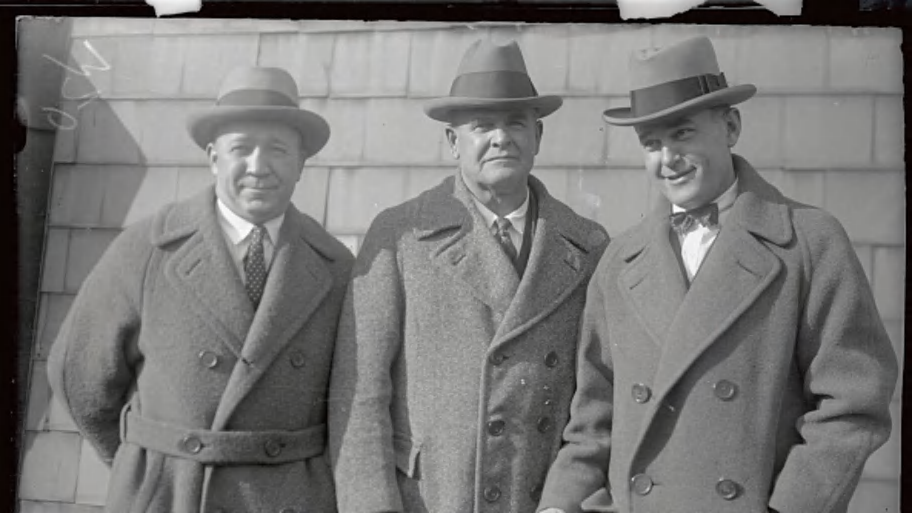
When the subject of conversation between two college football fans is Ohio State coach Ryan Day, the conversation will inevitably land on his formidable winning percentage. In seven years with the Buckeyes, Day has won 70 games and lost only 10.
It's an impressive clip, but even if Day met College Football Reference's 10-year minimum criterion, it would not be the largest in college football history. That belongs to legendary Notre Dame coach Knute Rockne, who went 105-12-5 during his 13-year career for a lifetime winning percentage of .881.
Rockne died nearly a century ago, but he continues to cast a powerful shadow over the game he helped grow into a national fascination. In grainy newsreel films and graying photographs, he used the power of mass media to cast himself as the ideal coach—a myth that endures to this day.
As another college football season rolls forward—and the coach's old program heads home—here's a look back at Rockne's career on the sidelines and the world he created.
What were college football and the world like when Knute Rockne began his coaching career?
In a word: small. That could apply to a number of challenges Rockne faced when he took the reins of his alma mater before the 1918 season.
The school was small; its team played a road game against future Division III school Wabash. College football was small and territorial. The American leisure economy was small thanks to World War I and a global influenza pandemic, and the Fighting Irish's schedule was the smallest it had been in seven years for similar reasons.
Even before he coached a down, Rockne's backstory hinted at a changing nation and game. He was an immigrant, having left Western Norway as a boy for Chicago's Logan Square neighborhood. He'd been something of a proto-wide receiver during his Notre Dame playing career, catching forward passes in the team's famous 1913 upset of Army. He had also played some professional football in Ohio and Indiana. All of the factors were in place for what we today would call a disruption.
How did Knute Rockne become college football's best coach?
Let's bust one myth here: broadly speaking, the Fighting Irish were quite good before Rockne arrived. His immediate predecessor, Jesse Harper, is in the Hall of Fame with a 34-5-1 record in five years. As far back as 1901, Notre Dame was reeling off 8-1-1 seasons, albeit against schedules that included Beloit and Lake Forest.
And yet—Rockne came to eclipse even Harper. After a 3-1-2 campaign in '18, the Fighting Irish embarked on a 20-game winning streak, next losing in 1921 after back-to-back 9-0 seasons. Before his career ended, Rockne added national championships in 1924 and 1929 and an unbeaten campaign in 1930.
It was a decade that lent itself to coaches who won in bunches, as most of the nation's top teams did not play each other due to the formidable transportation hurdles of the time. Even accounting for this, it remains remarkable that Rockne's losses can fit in one paragraph: to Michigan State (1918), Iowa (1921), Nebraska (1922, 1923, 1925), Army (1925, 1927), Carnegie Mellon (1926, 1928), Wisconsin (1928), Georgia Tech (1928), and USC (1928).
How did Knute Rockne change college football?
In the 1920s, as the American economy boomed after World War I, leisure time and new technologies changed the average fan's relationship with college football.
"You told a man that your school was No. 1 some 80 years ago and all he said was, 'That's swell but, excuse me, I got to go invent the airplane,'" SI great Dan Jenkins once wrote of the game's early days. Into history went that pastoral time, replaced by mass media—newspapers at scale, radio, and newsreel film. Mass media meant public debate, and public debate meant the advent of national ratings systems—an idea that would one day subsume college football whole.
Rockne was a master communicator and dramatist—a wit who is said to have remarked that "prayer works best when you have big players." The history books are filled with things Rockne may have done—he may have used the premature death of his best-ever player, George Gipp, to motivate a later team; he may have threatened to quit at halftime of a game on multiple occasions; his wife may have encouraged the institution of Notre Dame's rivalry with USC—and that is probably just the way he liked it. Even the Rockne stories that are beyond doubt fascinate. Yes, he really did (through a student publicist) have his '24 backfield pose on horseback to immortalize their "Four Horsemen" nickname; yes, he really did bail on a game against Carnegie Mellon to write about an Army-Navy game, an idea that backfired when the Fighting Irish lost 19–0.
What is remarkable about these stories is that they existed at all on the heels of a more modest age of college football coaching. Rockne was a brand, an idea new to a global economy beginning its century-long explosion in size. Throw in his financial savvy—he had a long promotional association with Studebaker, a South Bend-headquartered car company that boomed after World War I—and the road to Nick Saban's Aflac commercials had effectively begun.
His personality loomed so large that his tactical genius was almost beside the point, but there it was: ex-Notre Dame halfback Curly Lambeau cribbed Rockne's variant of the single-wing offense upon taking the Green Bay Packers' coaching job, and his squad won three NFL titles in a row from 1929 to '31.
What was Knute Rockne's legacy?
Rockne was 43 when—in March of 1931, mere months after wrapping up another fantastic season—he died in a plane crash in Kansas.
"I know that every American grieves with you," President Herbert Hoover told Rockne's wife Bonnie in a message. "Mr. Rockne so contributed to a cleanness and high purpose and sportsmanship in athletics that his passing is a national loss."
In the century since his death, Rockne has remained an elusive figure. "We Know of Knute, Yet Know Him Not," read the headline of a 1979 SI story by Coles Phinizy that drew on interviews with several still-living Rockne players.
This ignorance, however, is not for a lack of trying. In 1940, Pat O'Brien played Rockne in the film Knute Rockne, All American—a well-received biopic in which he wound up wildly overshadowed by co-star and future President Ronald Reagan, who played Gipp in his breakthrough role. In 1993, Rudy—the first film shot on Notre Dame's campus since Knute Rockne, All American—drew heavily on Rockne's mythmaking for inspiration.
What is clear as day, however, is Rockne's impact on the Fighting Irish—who became a prominent, persistent American Catholic identity symbol. After some inconsistent on-field years in the 1930s, Notre Dame hit another home run with the hire of Frank Leahy—a late-period Rockne tackle—away from Boston College after the 1940 season. Leahy's .864 winning percentage ranks second in college football history behind Rockne among those who coached a minimum of 10 years.
As for college football, thanks to this unlikeliest of candidates—the son of a Norwegian wagon-maker, a chemistry major and avid flutist—it has shown similar resilience and flair. And like Rockne, the game has made a little bit of money on the side, too.
More College Football on Sports Illustrated
This article was originally published on www.si.com as Who Was Knute Rockne? Notre Dame Legend Still Holds Winning Percentage Record.







